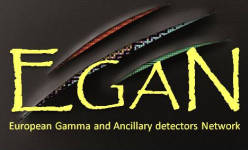Roberto Nicolini
(Università degli Studi di Milano and INFN, sezione di Milano)
30/06/11, 15:00
An AGATA-Demonstrator (AD) experiment to study the gamma decay from giant resonances at zero temperature has been performed in June 2010 at LNL. The giant resonance modes have been excited by inelastic scattering of 17O at 20 MeV/A (the highest energy available at LNL) on a series of targets, such as 208Pb, 90Zr and 140Ce. The scattered ions have been detected by two E-∆E Si telescopes of the...
Valeria Vandone
(Università degli Studi e INFN - Milano)
30/06/11, 15:17
The transition between order and chaos is studied in the warm rotating nucleus 174W by gamma-spectroscopy, focusing on the conservation of selection rules of the K quantum number with the excitation energy. The 174W nucleus was populated at high spins by the fusion-evaporation reaction of 50Ti (at 217 MeV) on a 128Te backed target. The measurement was performed in July 2010 at Legnaro National...
Fabio Crespi
(Università di Milano - INFN)
30/06/11, 15:34
In many in-beam gamma spectroscopy experiments the detection of high-energy gamma rays in the range up to 10-20 MeV is of primary importance. The performance of AGATA detectors in this energy range has, however, never been studied in detail.
A measurement of the response to 15.1 MeV gamma rays has therefore been performed using two HPGe triple clusters of the AGATA Demonstrator array,...
Barbara Melon
(INFN FI and Università di Firenze)
30/06/11, 15:51
We have investigated the ability of AGATA modules to measure the linear polarization of gamma rays, exploiting the dependence of the Compton scattering differential cross section on the azimuthal angle. To this purpose, enriched targets of 104 Pd, 108 Pd were bombarded by a 32MeV 12 C beam. Partially polarized gamma rays have been produced by Coulomb excitation of the first excited states of...
Carl Wheldon
(University of Birmingham)
30/06/11, 16:08
AGATA in conjunction with the TRACE charged particle detector, has been used to study the 16O(7Li, n p)21Ne* reaction. This experiment aims to measure both in-band transitions and transition rates in the excited cluster bands of 21Ne. A further goal is to identify the 'missing' K = 1/2, Iπ = 5/2− level, to resolve a long running discrepancy in the understanding of 21Ne. By facilitating the...

